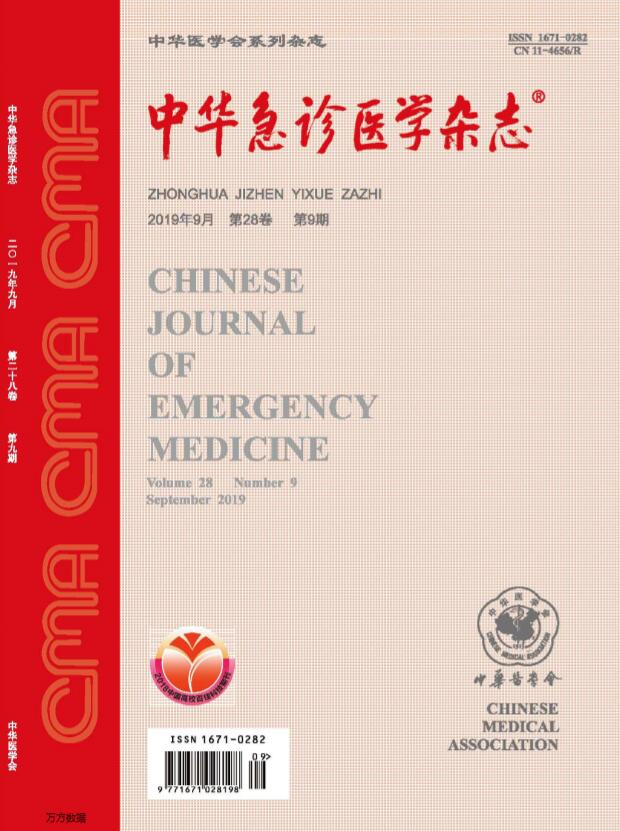The value of space glucose control in ICU stress hyperglycemia management
Q4 Nursing
引用次数: 1
Abstract
Objective To investigate the effect of space glucose control (SGC) on the quality of blood glucose management in ICU patients with stress hyperglycemia. Methods A prospective, cross-controlled, quasi-trial was conducted to observe patients with ICU-induced stress hyperglycemia between January 2018 and January 2019. Patients with conventional blood glucose management served as the control group, and SGC blood glucose management was used as the intervention group. The enrolled patients were interchanged between the two groups every 24 h, and the end point was 96 h. The differences in blood glucose management quality indicators between the two groups were compared, including the average blood glucose level, the highest and lowest blood glucose level, the average blood glucose monitoring interval, and the accumulated insulin dosage. SPSS 23.0 was used to analyze the data. The paired t test was used for the normal distributed data. Otherwise, two nonparametric correlation sample tests was used. A P<0.05 was considered statistically significant. Results A total of 41 patients enrolled in this study during the study period. The average blood glucose value in the intervention group was significantly lower than that in the control group [(8.60 ±1.42)mmol/L vs (10.02 ±1.49)mmol/L, P< 0.01]. The frequency of hyperglycemia was lower than that of the control group (16.59 ±8.56 vs 18.73 ±7.91, P=0.023). The frequency of blood glucose value in the target blood glucose range was significantly higher than that of the control group (53.07±19.11 vs 29.44±19.60, P< 0.01). However, the frequency of hypoglycemia, the frequency of blood glucose monitoring and the accumulated insulin dosage in the intervention group were higher than those in the control group [1 (0, 5) vs 0 (0, 2), P< 0 01; 1 36 ±0 23 vs 1 89 ±0 28, P< 0.01; and (139.61 ±77.06)U vs (107.49 ±64.41)U, P<0.01]. Conclusions SGC can optimize the control of blood glucose in the target blood glucose range, but it can easily lead to mild hypoglycemia, and to a certain extent increases the workload of medical staff. Key words: SGC; ICU patients; Stress hyperglycemia; Blood glucose management空间血糖控制在ICU应激性高血糖管理中的价值
目的探讨空间血糖控制(SGC)对ICU应激性高血糖患者血糖管理质量的影响。方法对2018年1月至2019年1月icu致应激性高血糖患者进行前瞻性、交叉对照、准试验观察。采用常规血糖管理的患者为对照组,采用SGC血糖管理的患者为干预组。将入组患者每24 h互换一次,终点为96 h。比较两组血糖管理质量指标的差异,包括平均血糖水平、最高和最低血糖水平、平均血糖监测间隔时间、胰岛素累积剂量。采用SPSS 23.0软件对数据进行分析。正态分布数据采用配对t检验。否则,使用两个非参数相关样本检验。P<0.05为差异有统计学意义。结果研究期间共有41例患者入组。干预组平均血糖值明显低于对照组[(8.60±1.42)mmol/L vs(10.02±1.49)mmol/L, P< 0.01]。高血糖发生率明显低于对照组(16.59±8.56 vs 18.73±7.91,P=0.023)。血糖值在目标血糖范围内出现的频率显著高于对照组(53.07±19.11 vs 29.44±19.60,P< 0.01)。但干预组低血糖发生次数、血糖监测次数及胰岛素累积剂量均高于对照组[1 (0,5)vs 0 (0,2), P< 0.01;1 36±0.23 vs 1 89±0.28,P< 0.01;(139.61±77.06)U vs(107.49±64.41)U, P<0.01。结论SGC可优化血糖控制在目标血糖范围内,但易导致轻度低血糖,并在一定程度上增加了医护人员的工作量。关键词:SGC;ICU患者;应激性高血糖;血糖管理
本文章由计算机程序翻译,如有差异,请以英文原文为准。
求助全文
约1分钟内获得全文
求助全文
来源期刊

中华急诊医学杂志
Nursing-Emergency Nursing
CiteScore
0.10
自引率
0.00%
发文量
8629
期刊介绍:
Chinese Journal of Emergency Medicine is the only national journal which represents the development of emergency medicine in China. The journal is supervised by China Association of Science and Technology, sponsored by Chinese Medical Association, and co-sponsored by Zhejiang University. The journal publishes original research articles dealing with all aspects of clinical practice and research in emergency medicine. The columns include Pre-Hospital Rescue, Emergency Care, Trauma, Resuscitation, Poisoning, Disaster Medicine, Continuing Education, etc. It has a wide coverage in China, and builds up communication with Hong Kong, Macao, Taiwan and international emergency medicine circles.
 求助内容:
求助内容: 应助结果提醒方式:
应助结果提醒方式:


